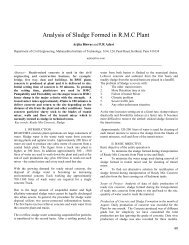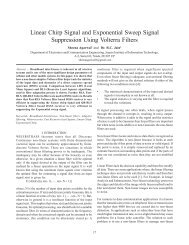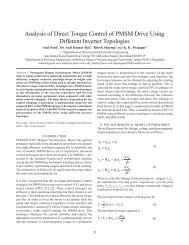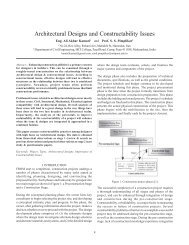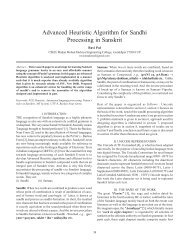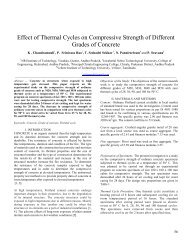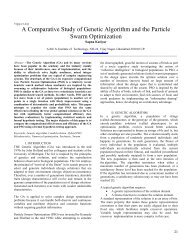Nash Equilibrium, Fermat Principle and Governing Dynamics.
Nash Equilibrium, Fermat Principle and Governing Dynamics.
Nash Equilibrium, Fermat Principle and Governing Dynamics.
You also want an ePaper? Increase the reach of your titles
YUMPU automatically turns print PDFs into web optimized ePapers that Google loves.
NASH EQUILIBRIUM<strong>Nash</strong> <strong>Equilibrium</strong>, <strong>Fermat</strong> <strong>Principle</strong> <strong>and</strong> <strong>Governing</strong> <strong>Dynamics</strong>Dr. Aniruddh SinghDepartment of Applied Sciences, Ajay Kumar Garg Engineering College, P.O. Adhyatmic Nagar,Ghaziabad 201009 UP IndiaAbstract -- <strong>Nash</strong> equilibrium in game theory involves multipleplayers where each player knows the strategies of the other player.The decision to change one’s strategies is based upon thestrategies of the other player. Under equilibrium, the playerscannot change their strategies without changing the strategiesof the other players. An important implication of the theory isthat the optimum output decided by each player that maximizesthe profit is not the best choice for the individual but for thewhole group.While dealing with such a concept which has shown immensepotential for application in modern economics, one realizes thata similar principle is encountered in physics in the name of<strong>Fermat</strong> principle in optics or the principle of least action in thetheory of fields.In case of <strong>Fermat</strong> principle, a light ray traveling in differentmedium follows a trajectory such that it is the path of least timefor the whole group of different media. The path in each mediummay not be the shortest but increase of path in one medium iscompensated by a decrease in another such that although thejourney in each medium may not be the best, the total pathbecomes the least. This corresponds to an equilibrium in amathematical sense <strong>and</strong> any physical system or state will fallinto such a globally optimal situation. This correspondence isshown in this paper <strong>and</strong> it is concluded that the governingdynamics of the physical universe <strong>and</strong> our day-to-day humanaffairs are linked at deeper level.Keywords: <strong>Nash</strong> equilibrium, <strong>Fermat</strong> principle.I. INTRODUCTIONTHE game theoretic perspective of any competitive systemrequiring decision at any point of time is: There is a win or losesituation in a game played between two or more players. Thepayoff table is presented in a form of a grid where loss <strong>and</strong>gain are shown as quantities with opposite numerical signs<strong>and</strong> loss for one contestant is equivalent to a gain for anothercontestant. The game can also be played between an individual<strong>and</strong> nature which administer the conditions of individualsurroundings. As an example consider a problem of Decisiontheory [1]. A producer of certain things must decide to exp<strong>and</strong>his plant capacity now or wait at least another year. His advisorstell him that if he exp<strong>and</strong>s now <strong>and</strong> economic conditions remaingood, there will be a profit of Re. 164000 during the next fiscalyear; if he exp<strong>and</strong>s now <strong>and</strong> there is recession there will be aloss of Re. 40000: if he waits at least another year <strong>and</strong> economicconditions remain good, there will be a profit of Re. 80000; <strong>and</strong>if he waits at least another year <strong>and</strong> there is a recession, therewill be small profit of Re 8000. What should the manufacturerdecide to do, if he wants to minimize the expected loss in thenext fiscal year <strong>and</strong> odds are 2 to 1 that there will be a recession?One can analyze the above problem by constructing a payofftable where gains are represented by a negative number <strong>and</strong>losses are represented by a positive number:Exp<strong>and</strong> nowEconomy remains good -164000 -80000There is a recession 40000 -8000Since the probabilities that economic condition will remain good<strong>and</strong> there will be recession are 2/3 <strong>and</strong> 1/3 the expected lossfor the current financial year is-164000 × 1/3 + 40000 × 2/3 = - 28000Whereas if he waits for the next year then the expected loss is:-80000 × 1/3 + (-8000) × 2/3 = -32000Delay expansionTherefore the manufacturer should wait for one year.This is asimple example of game theory taken from a college textbook[1] <strong>and</strong> is meant only as a precondition for appreciation of theconceptual features of <strong>Nash</strong> equilibrium.II. NASH EQUILIBRIUMAn account of <strong>Nash</strong> equilibrium can be found at several places.See for example [2]. Here we only give a basic outline whichwill be relevant to our purpose <strong>and</strong> suffice for the discussionthat is about to come. <strong>Nash</strong> equilibrium is a fundamentalconcept in the theory of games <strong>and</strong> the most widely usedmethod of predicting the outcome of a strategic dealings in thesocial or political sciences. Here we only discuss briefly the socalled pure strategy <strong>Nash</strong> equilibrium which is a subset of ageneral mixed strategy <strong>Nash</strong> equilibrium.A pure-strategy <strong>Nash</strong> equilibrium is an action profile with theproperty that no single player can obtain a higher payoff by29
AKGEC INTERNATIONAL JOURNAL OF TECHNOLOGY, Vol. 3, No. 2deviating unilaterally from this profile. Consider first a gameinvolving two players. Each has two possible actions, whichwe call X <strong>and</strong> Y. If the players choose different actions, theyeach get a payoff of 0. If they both choose X, they each get 2,<strong>and</strong> if they both choose Y, they each get 1. This is a kind ofcoordination game where the payoff is dependent on whetherthe two players coordinate or not. It may be represented asfollowing payoff table, where player 1 decides on a row, player2 decides on a column, <strong>and</strong> the resulting payoffs are listed inparentheses, with the first term in the parenthesescorresponding to player 1’s payoff <strong>and</strong> the secondcorresponding to 2’s payoff:XX (2,2) (0,0)Y (0,0) (1,1)Player 1 can choose either strategy X or Y. Depending uponthe choice of player 2, Player 1 can have the payoffs which areshown as the first value of each parentheses. Same holds forplayer 2 whose payoff is represented by the second value ineach bracket. The action profile (Y,Y) is an equilibrium, since aunilateral deviation to X by either 1 or 2 would result in a lowerpayoff for the deviating player. Similarly, the action profile (X,X)is also an equilibrium.Yactions available to each player has at least one mixed-strategyequilibrium [3].III. FERMAT’S PRINCIPLE<strong>Fermat</strong>’s principle in optics holds a very important position inthe sense that the path or trajectory of a given light ray isspecified by this law. In this sense, the <strong>Fermat</strong> principle is oneof the most basic law of physics.In this article I want to give an interesting connection between<strong>Fermat</strong>’s principle <strong>and</strong> <strong>Nash</strong> equilibrium. To do so, I musttranscribe this very important principle of physics in thelanguage of game theory.To start with, I must first describe the principle briefly.A moredetailed description can be found elsewhere [4].In optics, <strong>Fermat</strong>’s principle or the principle of least time saysthat the path taken between two points by a ray of light is thepath that is traversed in the least time. A beam of light travelingin different media does not take a straight path between twopoints which is the minimum spatial path but the actual pathbetween two points taken by the light beam is the one that istraversed in the least time. With its help, one can prove thelaws of reflection <strong>and</strong> refraction (Snell’s law) [4]. To come tothe central discussion of this paper, consider Fig. 1.In a game with pure strategy it is not necessary for anequilibrium to be present. As an example consider a gameknown as ‘matching pennies’. It is a game between two playerswhere each player can choose either a head or a tail. Player 1losses one penny if the choices are the same <strong>and</strong> wins twopennies if the choices are different. The payoff table is shownbelow:HTH (1,-1) (-1,1)T (-1,1) (1,-1)As can be seen this game with pure strategies does not have<strong>Nash</strong> equilibria. In several cases instead of choosing an actiona player’s behavior is determined by a probability distributionattached to set of all possible actions. Such a non uniformbehavior over a period of time when the game is playedrepeatedly, over a set of actions is referred to as mixedstrategies. A mixed strategy <strong>Nash</strong> equilibrium then correspondsto that probability distribution with the property that no playercan obtain higher returns by deviating unilaterally from actionprofile determined by the probability distribution.Just as passing mention, in 1950 John <strong>Nash</strong> an Americanmathematician showed that every game with a finite set ofFigure 1A light ray can either start from point A or point B in the figure.A ray starting from point A can take any arbitrary path. Threepossible paths are shown in the figure. They are labeled asAyB, AxB <strong>and</strong> AzB. Out of the three, AyB is the path of leasttime <strong>and</strong> is the actual path of the light beam.Let us take the to <strong>and</strong> fro journey of light from point A to pointB <strong>and</strong> back to A as a sort of a ping-pong game between twoplayers A <strong>and</strong> B. Any transaction initiated by A is equivalentto the light ray starting from A <strong>and</strong> ending at B. Any transactioninitiated by B is equivalent to a ray starting from B <strong>and</strong> ending30
NASH EQUILIBRIUMat A. x, y <strong>and</strong> z are the strategies <strong>and</strong> the optical path length ofeach transaction is taken as a payoff. The minimum path AyBis taken as reference <strong>and</strong> hence Ax=0 <strong>and</strong> Bx=0 such that AyB=0.Similarly since any other optical path (i.e. AxB or AzB or theirreverse) is longer than AxB, it is taken as -1. The value is takenas negative as a longer optical path requires a longer time <strong>and</strong>is less economical <strong>and</strong> hence considered as a loss.The payoff table is shown below.The rows are strategies(x, yor z) decided by A <strong>and</strong> columns are those by B. The first valuein the parentheses is the path length of transaction initiatedby A <strong>and</strong> the second value is that initiated by B which in ourcase is equivalent to the payoff.x y zx (-1,-1) (-1,0) (-1,-1)y (0,-1) (0,0) (0,-1)z (-1,-1) (-1,0) (-1,-1)IV. CONCLUSIONAn interesting connection has been explored between theprinciple of least time in physics <strong>and</strong> <strong>Nash</strong> equilibrium in gametheory. It has been shown that the principle of least time aswell as the principle of reversibility of ray optics finds asupportive argument when it is transcribed in the game theoreticlanguage <strong>and</strong> can be taken as an independent <strong>and</strong> uniquetestimony of universality of these concepts. At the same timefurther study can reveal other interesting connections <strong>and</strong>possible generalizations.V. REFERENCES[1] Freund <strong>and</strong> Walpole: Mathematical Statistics, Fourth Edition.Page 306-308.[2] Osborne, Martin J., <strong>and</strong> Ariel Rubinstein. A Course in GameTheory. Cambridge, MA: MIT, 1994. Print.[3] <strong>Nash</strong>, John (1950) “<strong>Equilibrium</strong> points in n-person games”Proceedings of the National Academy of Sciences 36(1):Page48-49.[4] Eugene Hecht: Optics, Fourth edition, Page 102-107.As can be seen from the table, the action profile (y,y) is a <strong>Nash</strong>equilibrium which corresponds to the actual path both in theforward journey from A to B <strong>and</strong> also the reverse journey fromB to A. This also falls into place with the principle of reversibilityin ray optics. As there are no other <strong>Nash</strong> equilibrium in thisgame, this becomes important when we consider theuniqueness of the solution of the principle of least time in agiven optical system.Dr. Aniruddh Singh is PhD in TheoreticalNuclear Physics from Jamia Millia Islamia, NewDelhi.He obtained BSc Hons in Physics from DelhiUniversity <strong>and</strong> MSc Physics from IIT, Kanpur.His PhD thesis is in the field of Variational MonteCarlo methods as applied to light nuclei <strong>and</strong>hypernuclei. He has seven years of teachingexperience at various universities <strong>and</strong> about 1.5years research experience in industry.Currently, he is an assistant professor with theDepartment of Applied Sciences, Ajay Kumar Garg Engineering College,Ghaziabad.31



